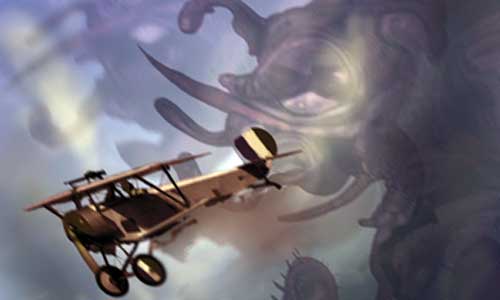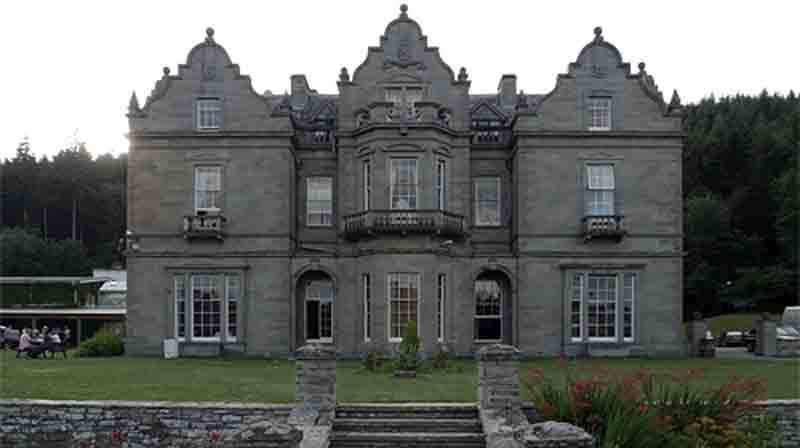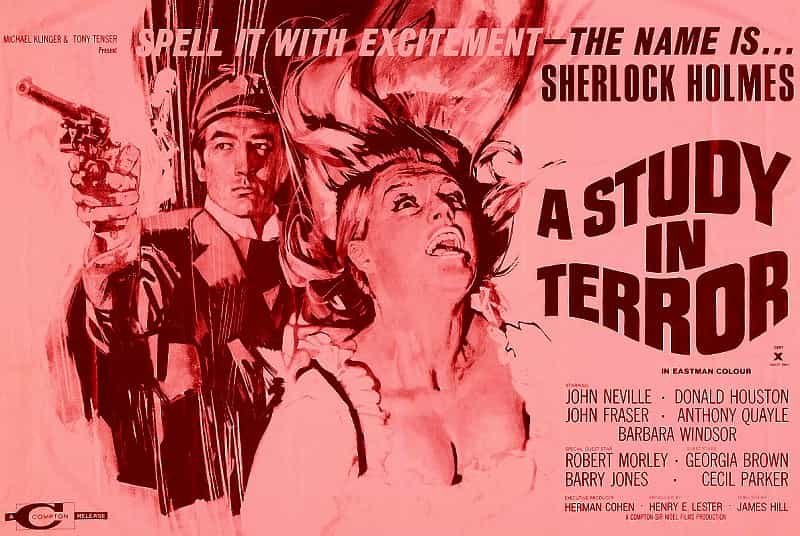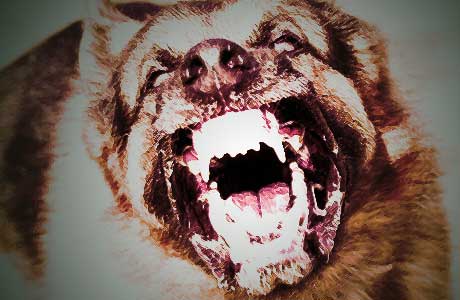MICHAEL S. COLLINS takes a look at Arthur Conan Doyle’s ground-breaking The Horror of the Heights

The Horror of the Heights, an early 20th century horror tale by Arthur Conan Doyle, has one of the greatest last lines in all of horror. But to speak of it now, in the manner of those who write Who Cares Who Killed Roger Ackroyd, would be to not only spoil the piece, but to rob it of its context. The Heights is a modern (by its time) tale of a pilot who finds something troublesome high up in the clouds and meets his maker.
It is a curious tale of Elementals striking upon the mere mortals who stumble into their lair. It is, if you will allow, a prime example of a Lovecraftian universe story, from before HP Lovecraft even began to write. Here we have creatures of some sort living over 40, 000 feet above the ground, which can only be stumbled upon by curious and doomed peoples with monoplanes. [40, 000 feet is twice the horror for William Shatner, incidentally…]
Not only does Conan Doyle invent Lovecraftian horror (though one could claim they were both inspired by the more macabre of Arthur Machen’s works), he also decides to play with the tropes of the found footage genre. For this tale is told in the excerpts of a blood-stained diary (I love that, not only is the diary found, it’s blood-stained!) found torn and lost in a field in the middle of nowhere, England.
“The Joyce-Armstrong Fragment was found in the field which is called Lower Haycock, lying one mile to the westward of the village of Withyham, upon the Kent and Sussex border..he caught sight of a flat, canvas-backed book, which proved to be a note-book with detachable leaves, some of which had come loose and were fluttering along the base of the hedge.
These he collected, but some, including the first, were never recovered, and leave a deplorable hiatus in this all-important statement. The note-book was taken by the labourer to his master, who in turn showed it to Dr. J. H. Atherton, of Hartfield. This gentleman at once recognized the need for an expert examination, and the manuscript was forwarded to the Aero Club in London, where it now lies.”
We can see even within this introduction (and how Holmesian that the piece is called a fragment) that Doyle is working within the context of how academics wrote horror at the time. Think of M.R. James. They start by explaining how the facts were ascertained by learned colleagues and institutions, so as to give a verisimilitude of truth to the spooky goings on.
Here in, Doyle shows that he is a great fan of the short horror story, as he can work not only with its tropes, but also poke gentle fun at them, and casually use things (such as the “found footage” style of narration) which would become clichés and stereotypes, long after his death, thanks in no small part to his own work.
The man Joyce-Armstrong finds that curiosity most certainly killed this particular cat. Though given he narrowly escapes the first encounter, and then returns to the air to find them again, one can’t say he wasn’t given ample warning! Even if he was prone to taking a shotgun with him, how do you think a shotgun would do against Cthulhu? Spoiler warning: not very well.
Arthur Conan Doyle was on record as much preferring his own horror and ghost tales to the works of the great detective, and there is verve to much of his written horror. But one certainly feels that the horror helped the detective tales come along, and the detective tales helped improve the horror. You can prefer one genre to the other, but you can’t have The Dying Detective without the story it directly succeeded.
Listen to The Horror of the Heights (1913)
Conan Doyle, the Horror Story and Spirits
MATT WINGETT, author of Conan Doyle and the Mysterious World of Light, discusses the Sherlock Holmes author’s love of the macabre
(Article originally published on Spooky Isles on 9 February 2016.)
When in 1882 the young Arthur Conan Doyle took up residence above his new practice at No.1 Bush Villas, Elm Grove, Southsea, it is said he was astonished to find piled in his basement stacks of human jaws grinning at him – the jawbones of numerous people who had visited that building in the preceding years.
It is a detail from his life worthy of an episode of his great detective, Sherlock Holmes, whom he was to create during his extraordinarily fruitful stay in Southsea between 1882 and 1890.
From the very beginning, elements of the Gothic filled Conan Doyle’s stories, revealing an imagination and a thought process fascinated by the unknown and apparently inexplicable.
Long before he strode on to the world’s stage to evangelise Spiritualism his tales already included moments of spiritual contact. In the spine-tingling conclusion to his 1890 short story The Captain of the Polestar, the narrator observed near the body of the eponymous Captain an inexplicable vision in the vast Arctic wastes.
He was lying face downwards upon a frozen bank. Many little crystals of ice and feathers of snow had drifted on to him as he lay, and sparkled upon his dark seaman’s jacket. As we came up, some wandering puff of wind caught these tiny flakes in its vortex, and they whirled up into the air, partially descended again, and then, caught once more in the current, sped rapidly away in the direction of the sea.
To my eyes it seemed but a snow-drift, but many of my companions averred that it started up in the shape of a woman, stooped over the corpse and kissed it, and then hurried away across the floe. I have learned never to ridicule any man’s opinion, however strange it may seem.
It is a moment straight from the Romantic tradition. The Arctic setting echoes the denouement of Mary Shelley’s Frankenstein – another writer who skilfully combined elements of science and spirit to ask philosophical questions and create a supernatural thrill.
Other early works also show his love of the unexplained and the occult. His horror novel, The Mystery of Cloomber employs reincarnation, karma and astral projection in a tale of vengeance involving a cursed army General who killed a Buddhist in India, for whom it all ends badly in the desolate Scottish countryside.
Conan Doyle’s love of the apparently inexplicable also suffused the stories starring his greatest creation, Sherlock Holmes. From the glowing supernatural appearance of The Hound of the Baskervilles through the macabre murder near the beginning of The Sign of Four, in which a mysterious small-footed creature appears to materialise inside the victim’s bedroom, to the sprawling ivy-covered mansion of Abbey Grange where a body is discovered with its head battered in using, as Conan Doyle tells us for extra detail “his own poker”, there is a gory and otherworldly aspect over which Holmes eventually casts the cold light of reason.
Reading the Holmes stories in isolation, one might not guess the driving force in Doyle’s nature – an imagination that revelled in mystery of any kind, be its genesis material or spiritual.
Just so with the short story Lot No 249, published in 1892, the same year The Adventures of Sherlock Holmes began to appear in The Strand. It tells the ghoulish tale of Edward Bellingham, an Oxford student with an unhealthy interest in necromancy, who shares a Gothic turret with two other students and an ancient Egyptian mummy which Bellingham bought at auction.
After reanimating the long-dead mummy, Bellingham uses it to remove one of his room-mates as a rival in love. Finally, he is forced at gunpoint by his other room-mate to destroy it. Doyle describes the moment with wonderful ghastly detail:
“In frantic haste he caught up the knife and hacked at the figure of the mummy, ever glancing round to see the eye and the weapon of his terrible visitor bent upon him. The creature crackled and snapped under every stab of the keen blade. A thick yellow dust rose up from it. Spices and dried essences rained down upon the floor. Suddenly, with a rending crack, its backbone snapped asunder, and it fell, in a brown heap of sprawling limbs, upon the floor.”
Doyle was a master of horror as well as the detective fiction he is renowned for. Both genres reflected two of the main currents in Victorian culture: the huge advances being made in science and the tumult in which religion found itself post-Darwin. It is this rich mixture that was to have such a profound influence on Doyle’s thinking and his writing – and which contributed so dramatically to his personal belief in spirits.
It is this belief that I explore further in Conan Doyle and the Mysterious World of Light.









